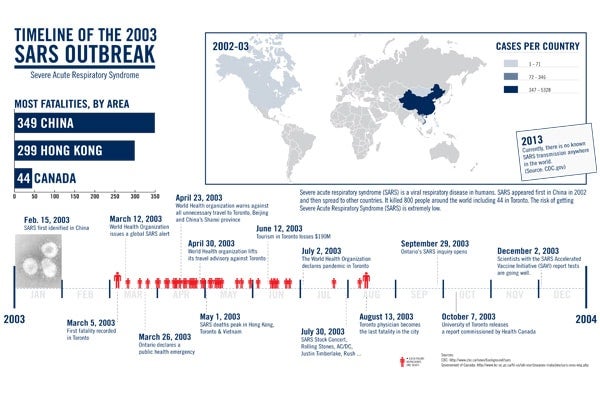
Teaching in a time of crisis: looking back at SARS
Published: April 5, 2013
It has been 10 years since severe acute respiratory syndrome (SARS) crept into Canada and paralyzed Toronto.
No one was prepared--hospitals were caught unaware and health care professionals struggled to make sense of a deadly virus that initially looked and felt like the common cold and flu. During these turbulent months, 44 people in Canada would lose their lives, including three health care workers.
The University of Toronto's Faculty of Nursing wrestled with how best to keep students safe. The nursing community was at the front line of the outbreak, facing both physical risk and stigma as the public responded to the mystery of SARS with understandable fear. With these obstacles in mind, faculty continued teaching and created their blueprints for how to educate during a crisis.
Ensuring each student would complete their year was a primary focus, but the Faculty also had to lay the foundations for future emergency preparedness response in the process. Writer Kendra Hunter explores what it was like to carry on teaching and researching during the outbreak and the lessons learned from SARS.
Communication
“We learned quickly that communication is critical at a time like this,” says Senior Lecturer Geraldine (Jody) Macdonald, who was chair of the undergraduate nursing program during the SARS crisis. “Faculty, students, the university, health care providers, the city and the province - everyone does really need to be on the same page.”
For nursing students, the Faculty’s September 2002 decision to implement WebCT, an online learning application, provided the means to complete educational models in a virtual environment. Replacing the clinical setting with a virtual one opened up a number of clinical teaching possibilities, while keeping students safe from the potential of SARS cross-contamination.
This foray into e-learning also proved to be an essential tool in communicating with students and continuing with schooling. Just a few short weeks after the first wave of SARS, Macdonald received the call that all students were to be pulled from clinical practice. WebCT functioned as a temporary substitute for clinical placements. Students now had the chance to continue learning despite having their seven-week or 12-week placements cut short by the crisis.
“The call came on March 27, 2003 — the day after the province of Ontario declared SARS a public health emergency,” says Macdonald. “Every undergraduate nursing student had to be pulled from their clinical settings because of the SARS outbreak. Without concrete information on what this virus was, we had no idea when, or if, they would be able to go back.
"In the second wave of SARS, we had a reversal. Students were back in the clinical setting but removed from the classroom. We used our on-line system to support classroom learning for this time period.”
Faculty needed to stay on top of the daily, and sometimes hourly, SARS information coming from the media, Toronto Public Health and the Ministry of Health and Long-Term Care. How courses and clinical placements would continue hinged on information from these sources. In this time before social media, hi-speed Internet and even, for some people, email, communicating clearly and effectively with students was a challenge. In response, the faculty created a SARS management committee.
Macdonald and Edith Hillan, who was then associate dean, Academic Programs and is now vice-provost at U of T, organized the committee with others to manage the flow of constant, frequently contradictory information, and determine how best to relay it to students.
“We had the great fortune to have Betty Burcher join our faculty six months before SARS hit,” says Macdonald. “Her years managing people and information at Toronto Public Health meant she knew the key players, knew how to think through the information we were receiving, and helped guide our SARS committee. Tracking undergraduate and graduate student attendance to manage potential exposure was one critical measure Betty suggested, and the committee implemented, to keep our students safe.”
The committee met daily to gather and disseminate information, in order to make decisions based on the SARS updates. Managing student fears and concerns about potentially losing their year while trying to teach the program was a delicate balance for the faculty. Add to that overwhelming feelings of uncertainty, the stigma surrounding nurses and their families, and the faculty were left feeling exhausted – alongside anyone working in health care during the crisis.
“Some of the toughest calls we had to make were to students saying they were pulled from clinical placements, and having to tell other students they were at risk of infection and would have to enter a 10-day quarantine,” says Macdonald. “Despite all of this, the students were able to complete their education and graduate that year. That speaks volumes about the dedication and commitment of the students who come to this program and their faculty.”
These results showed the fortitude of students enrolled in the program and the lengths to which the faculty went to support them. The success of integrating online learning, maintaining informed communications, and being flexible and innovative strengthened the Faculty of Nursing’s resilience and ability to support student learning during this time of emergency.



